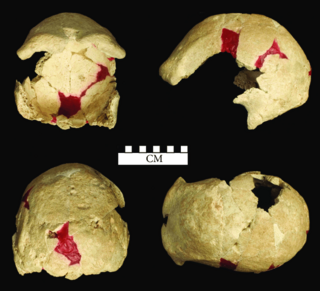 W
WThe following tables give an overview of notable finds of hominin fossils and remains relating to human evolution, beginning with the formation of the tribe Hominini in the late Miocene, roughly 7 to 8 million years ago.
 W
WArdipithecus kadabba is the scientific classification given to fossil remains "known only from teeth and bits and pieces of skeletal bones," originally estimated to be 5.8 to 5.2 million years old, and later revised to 5.77 to 5.54 million years old. According to the first description, these fossils are close to the common ancestor of chimps and humans. Their development lines are estimated to have parted 6.5–5.5 million years ago. It has been described as a "probable chronospecies" of A. ramidus. Although originally considered a subspecies of A. ramidus, in 2004 anthropologists Yohannes Haile-Selassie, Gen Suwa, and Tim D. White published an article elevating A. kadabba to species level on the basis of newly discovered teeth from Ethiopia. These teeth show "primitive morphology and wear pattern" which demonstrate that A. kadabba is a distinct species from A. ramidus.
 W
W"Giant of Castelnau" refers to three bone fragments discovered by Georges Vacher de Lapouge in 1890 in the sediment used to cover a Bronze Age burial tumulus, and dating possibly back to the Neolithic. According to de Lapouge, the fossil bones may belong to one of the largest humans known to have existed. He estimated from the bone size that the human may have been about 3.50 m tall. No modern peer-reviewed study has been published about the alleged giant bone fragments.
 W
WGraecopithecus is an extinct hominid that lived in southeast Europe during the late Miocene around 7.2 million years ago. Originally identified by a single lower jaw bone bearing a molar tooth found in Pyrgos Vasilissis, Athens, Greece, in 1944, other tooth specimens were discovered from Azmaka quarry in Bulgaria in 2012. With only little and badly preserved materials to reveal its nature, it is considered as "the most poorly known European Miocene hominoids." The creature was popularly nicknamed 'El Graeco' by scientists.
 W
WMeganthropus is an extinct genus of non-hominin hominid ape, known from the Pleistocene of Indonesia. It is known from a series of large jaw and skull fragments found at the Sangiran site near Surakarta in Central Java, Indonesia, alongside several isolated teeth. The genus has a long and convoluted taxonomic history. The original fossils were ascribed to a new species, Meganthropus palaeojavanicus, and for a long time was considered invalid, with the genus name being used as an informal name for the fossils.
 W
WPředmostí 3 was an Upper Paleolithic Homo sapiens from the Czech Republic, geologically dated to the Late Pleistocene.
 W
WThe Trachilos footprints are tetrapod footprints which show hominin-like characteristics from the late Miocene on the western Crete, close to the village of Trachilos, west of Kissamos, in the Chania Prefecture. Researchers describe the tracks as representing at least one apparent hominin or an unknown primate. The stratum in which the footprints were found was dated to about 5.7 million years ago, which predates the previously earliest discovered hominin footprints by about two million years. The researchers of the tracks suggest that it may imply the possibility of hominin evolution outside of Africa, contrary to the current theory.
 W
WFossil WLH-50 is a partial cranium fossil that was discovered in 1982, in the Willandra Lakes Region of Australia and was reconstructed by Alan Thorne. Speculation surrounds the exact age of this fossil hominid and a debate concerning its ancestry in relation to other late Pleistocene hominids, as well as, Ngandong hominids due to their close resemblance to one another.